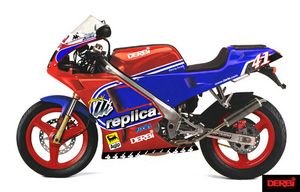Derbi: Big Fun in Small Packages - Motorcycle.com
Get the Flash Player to see this player.
If you were to guess from the kinds of motorcycles on our roads today, you might think the future will reveal more powerful and larger displacement sportbikes, dirtbikes and cruisers every year, until a literbike is regarded as a learner's tool and any cruiser under 2000ccs a "chick bike."
It's easy to hold this perspective in the USA, but a visit to a few other nations might change this view. In China, for instance, a 250 is seen as a seriously big bike suitable for the police or privileged Party apparatchiks. Japan requires a special license for just about every displacement category over 50cc, with anything over 400cc difficult and expensive to get.
In Spain and other European nations, restricted (meaning power output is limited so the vehicle can't exceed 30mph) 50cc motorcycles and scooters are legal to ride by youths as young as 14. This has created a lucrative market, giving rise to some fascinating machinery that is unavailable in the USA. 50cc dual sports, super motards and incredibly high-performance sportbikes with disc brakes, adjustable suspension, alloy frames and full fairings are in the motorcycle shops there from many manufacturers.
Since most of these victories were in the 125 or smaller classes, Derbi really knows how to make a lightweight, powerful two-stroke engine. The basic 50cc air cooled scooter engine has powered thousands and thousands of ring-dinging tiddlers all over Europe.
Derbi's relationship with the US market has been on-again and off-again for the last 40 years. Rental companies loved Derbi's mopeds in the 70's, as they made a model with collapsible pedals that could be rented to non-licensed riders, as well as other models popular during the 70's moped craze. However, Derbi never fully established itself in the U.S. as a series of small importers would bring in a few containers at a time and then abandon importation of bikes and parts.
In 2002, I was working at the Derbi dealer in San Francisco when my wife decided she missed her motorcycle enough to want a scooter to ride to work. She wouldn't need a particularly fast scooter, just something light and manageable, with room for her helmet under the seat.
I shouldn't have worried. The scooter warmed up in 20 seconds, and shot out into traffic when I wound the throttle to the stop. Soon I was rocketing out down Fell street at an indicated 55 miles per hour! The brakes weren't the strongest, as you would expect from a miniature 190mm disc, but the rear drum was surprisingly effective, so as long as you weren't two-up, you could stop pretty well. The 49 inch wheelbase and 12" wheels gave new meaning to the word nimble. After a while my wife started to complain that I was riding our new scooter more than she was, even though I had two or three bigger motorcycles in my garage at any given moment.
My first ride on the SM50 was incredible- it was the lightest, best-braking, best wheelie-ing, best handling motorcycle I had ever experienced! No wonder 125 two-stroke road racers go on and on about how great their race bikes are. There is no substitute for light weight to maximize motorcycle handling, braking and acceleration.
A friend of mine was looking for a fleet of motorcycles to start a Supermotard training school, and I told him about the SM50s. He was interested, and purchased the first two we got to test out.
The first section of our Sunday Ride is a gnarly, bumpy stretch of pavement along the cliffs of West Marin north of San Francisco. Horsepower is a liability on this piece of road, and the fastest riders by far are on beat-up dual purpose and Super Motard machines. We only had 8 HP, but on a motorcycle that's half the weight of the next lightest streetbike, it's enough to go at a good clip on slower roads.
My friend Justin acclimated to the 180-pound two-stroke right away. Following him up the hill, I watched as he "experimented" with the back tire's adhesion limits by going into a wicked slide from which he easily and expertly recovered. He then just took off out of sight, as I was not quite confident with the dual sport/Supermotard riding style. I fell to about 1/4 mile behind him and held my position, pulling up at the first rest stop a few minutes behind everybody else.
The next 25 miles of coast is much faster: smooth, flowing turns that are banked and comfortable to ride at triple-digit speeds. This meant I would be left behind, but we saw another rider coming from the north, frantically signaling there was CHP ahead of us. Everybody slowed to 55: the Derbis top speed! I laughed and had fun racing the bigger bikes into the tighter turns.
After breakfast, we started an impromptu 1/32 mile paved flat track race. Two of the grizzled old Ride veterans took the pair of little bikes and raced each other around and around the parking lot, sliding into the turns sideways and passing each other with inches to spare. The little bikes were the greatest thing these guys had seen in a long time!By the end, I didn't want to go home!
I learned more about traction and motorcycle handling dynamics in a morning than I learned my whole first 5 years of riding. I got home and took my old FZR out- I was able to apply the stuff I learned instantly and felt smoother, faster, and more confident. The SM 50 is an amazing teaching tool.
More by Gabe Ets-Hokins


































Comments
Join the conversation